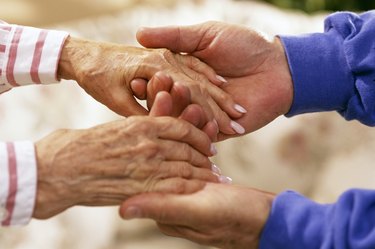
Both exercise and aging can cause the veins in your hands to bulge, but for different reasons. In either circumstance, the bulging veins are probably normal. If the appearance of the veins bothers you, you can seek treatment to diminish the protrusion of the veins. In some circumstances, however, bulging veins are caused by vascular disease, and you will need to seek medical treatment to treat the cause of the bulging veins.
Pump It Up
Video of the Day
Veins often bulge during exercise but then diminish once you are at rest. During exercise, arterial blood pressure increases, forcing the plasma from the blood to pool around the muscles and causing the muscles to swell and harden. As a result, the veins are pushed toward the surface of the skin, making them appear more prominent.
Video of the Day
The appearance of veiny hands may also become more pronounced if you lift weights because your muscles are temporarily swollen, which also works to push the veins to the surface of the skin. Workout supplements, such as creatine, can also lead to bulging veins.
Read more: How to Get Ripped Veins in Arms
Understand the Effects of Time
As you get older, the skin becomes thinner and less elastic, causing it to settle over the veins and fine bones in your hands. As a result, your veins may appear more prominent. Despite their bulging appearance, the veins themselves did not change, and prominent veins due to loss of skin elasticity do not indicate an underlying medical problem. These veins should not be confused with varicose veins or other vascular problems because their appearance is only a cosmetic issue.
Treat Bulging Veins
If you are dissatisfied with the appearance of your hands, you can undergo sclerotherapy. During sclerotherapy, the physician will inject the prominent veins in your hands with a solution that will cause the vein to collapse. This will lessen the bulging appearance of the vein, and reroute the blood to deeper veins that are less noticeable.
However, sclerotherapy is not without its risks. Although rare, side effects can include stroke, heart attack, blood clots and less dangerous symptoms such as pain or ulcer formation.
Read more: Leg Veins and Pain After Exercise
Consider Varicose Veins
Your veins may stretch with age, which makes the valves that prevent the blood from flowing backward from working efficiently. When the blood is not prevented from flowing backward into your veins, the veins may become enlarged and painful, causing your hands to swell. These are known as varicose veins.
Unlike for skin stretching due to aging, you need to seek medical attention for varicose veins because they may become debilitating over time, or they may occur along with more serious symptoms of vascular disease such as blood clotting disorders.
Be Aware of Blood Clots
A blood clot, or deep vein thrombosis (DVT) can be confused with a bulging vein. Although DVTs can occur in the arm, they typically develop in the lower leg. In some cases, DVTs can dislodge and travel to the lungs — a life-threatening condition. In addition to swollen veins, DVTs often cause redness and warmth of surrounding skin and are typically painful.